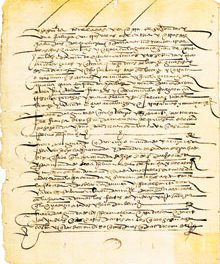The end zone for the race was the mouth of the St. John’s River. France’s Fort Caroline was just a few miles inland on the river. However, whoever got to the mouth of the river had a decisive advantage because they could more easily prevent the enemy’s ships from entering the river and finding the French fort. Spain’s top military leader, Pedro Menendez de Aviles, led the Spanish armada. France’s top admiral, Jean Ribault, led the French armada. Ribault won the race to the mouth of the river. This was largely because Pedro Menendez’s armada was badly damaged by a hurricane.
Thus, when Menendez approached the mouth of the St. John’s River on September 4, he saw five of Ribault’s ships anchored on the ocean side of the river inlet. And he saw two smaller ships inside the entrance of the river. Spain’s Menendez had lost the race.
So what did Menendez do? Rather than fight a defensive battle with the French, he took his small armada of five Spanish ships to the river inlet that was thirty miles south – the inlet to St. Augustine. But that inlet entrance only had a shallow depth of 1.5 fathoms, or 9 feet, at low tide. Thus, Menendez could only send his three smaller ships into the bay of St. Augustine. The two larger galleons could not clear the entrance.
This historical fact tells us one thing. It was never the intention of Spain, or France, to make St. Augustine their first major settlement. Why? Because both countries needed their first settlement to be at a site where their cross-Atlantic galleys could both unload and be protected inside a deep harbor. That is exactly why Dr. Eugene Lyon and Dr. Paul Hoffman (our nation’ top two 16th century colonial historians) have repeatedly stated, “St. Augustine was an accident!” The first major European settlement was Santa Elena, because it had the widest and deepest known harbor in the 16th century. St. Augustine became a significant settlement in the 17th and 18th centuries. But it was only a military garrison by 1580. On the other hand, Santa Elena had 327 settlers, of all occupations, by 1569.
France’s Admiral Jean Ribault beat Pedro Menendez to Fort Caroline in September of 1565. However, through ingenuity, and with help from the right weather, Menendez destroyed Ribault’s fort and armada. An untimely hurricane had also sent most of Ribault’s ships to the rocks. At a time when most of Europe’s armies would either execute or ransom enemy soldiers, one captured French ship pilot informed Pedro Menendez that he had information he believed should be worth of saving his life. Menendez responded, “If what you have is important, I will save your life.” Then, the French ship pilot said this.
“It was not the intent of either Admiral Coligny, the Queen Mother, or Admiral Ribault to just reinforce Fort Caroline. Their plan was nothing less than to destroy all of Spain’s holdings in the new world. That includes the Spanish Caribbean Islands, New Spain (Mexico), Tierra Firme (Panama, Columbia, Peru) and all of La Florida. Once Jean Ribault defeated you at Fort Caroline his title was to be Governor of New France. New France would include all of the Spanish territory that I just mentioned. The plan is to send a French-English armada here next April. The first step is to set a trap to attack the Treasure Fleet that will be returning from New Spain next spring. However, before the Spanish armada will arrive in April, Jean Ribault would be ordered to go to the Martyrs (The Florida Keys) with eight hundred men and build a fort. Thus, by April of 1566 France would have two forts to ambush the Spanish fleet – one at the Keys and one at Fort Caroline. The French fort at the Keys is to be constructed for a second reason. By summer Jean Ribault will take his armada to Cuba and take Havana. He will take them by freeing the slaves and creating slave revolts. From Havana he will jump to Hispaniola, Puerto Rico, New Spain (Mexico) and then to Panama, Columbia, and Peru.”
Pedro Menendez granted the French pilot his life.
So how important is the Santa Elena story? It is enormously important. Before France and Spain raced to the Jacksonville area in 1565, Santa Elena was targeted by both countries to be the first major European settlement. St. Augustine, as Dr. Eugene Lyon pointed out, was just an accident. Last weekend I spent two days in St. Augustine with one of their historians. During my stay I asked him this question: “Do most of the city’s historians still see St. Augustine as Europe’s first settlement?” His answer surprised me. “No, most of them now see Santa Elena as the first major settlement. St. Augustine was just an accident.”
Santa Elena, however, was destined to be much more than the first major European settlement. It was destined to be the port that would penetrate and discover the interior of what is now the United States. After Pedro Menendez destroyed Fort Caroline and Jean Ribault in the Spanish peninsula of La Florida, his first step was to build Santa Elena. In 1566 Governor Menendez ordered one of his captains to start building an inland road to Spain’s Mexican mines. By 1567, Captain Pardo got as far as Tennessee. When we look back over the history of the United States, we can see that our country was settled over time in many areas. The English settled Jamestown and Plymouth. The Irish settled in Boston. The Scandinavians settled in Minnesota and the Dakotas.
But from a timeline perspective, the United States was first settled at Santa Elena.









